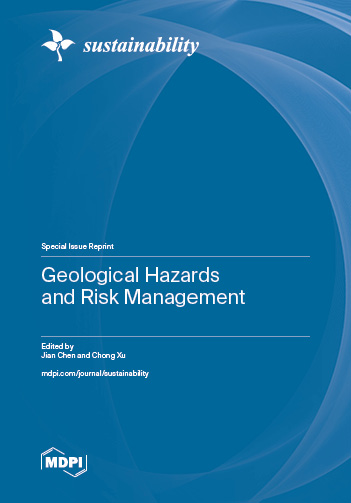Geological Hazards and Risk Management
A special issue of Sustainability (ISSN 2071-1050). This special issue belongs to the section "Hazards and Sustainability".
Deadline for manuscript submissions: closed (30 September 2023) | Viewed by 67225
Special Issue Editors
Interests: geological hazards; landslides; engineering geology; risk assessment
Interests: earthquake-triggered landslides; rainfall-triggered landslides; active faults; hazard and risk mapping; landslide inventory
Special Issues, Collections and Topics in MDPI journals
Special Issue Information
Dear Colleagues,
Geological hazards worldwide are known to be exacerbated due to climate change and anthropogenic activities, with more frequent ice avalanches, glacial activities, glacial lake bursts and alpine debris flows in high mountain regions, increasing the exposure and vulnerability of mountain settlements. Furthermore, catastrophic geological hazards sometimes produce a chain effect, that is, one hazard triggers another hazard in succession, leading to the amplification of the damage to the environment and human society. Although researchers have developed and used different approaches and strategies in the processes of geohazard field investigation, risk assessment, early warning, long-term monitoring and mitigation, advanced methods and cases on sustainable risk management still call for ongoing attention.
Risk management of geological hazards involves the application of some concepts or models to seek reasonable and effective recommendations for risk prevention and mitigation. By coordinating the relationship between human activities and geohazards, geohazard risk management has become an integral component of sustainable social development, as well as an important guarantee for reducing loss of life or injury, social economy and environmental losses caused by geological disasters and their secondary disasters.
The objective of the proposed Special Issue is to assemble original papers related to recent developments in theoretical frameworks, methodologies and applications for geohazard risk management from different worldwide regions. Case studies and review articles on assessment, early warning, long-term monitoring and mitigation are also welcome. It is expected that the Special Issue will provide the latest developments for institutions and stakeholders related to geohazard risk management on a global or regional scale.
We look forward to receiving your contributions.
Prof. Dr. Jian Chen
Prof. Dr. Chong Xu
Guest Editors
Manuscript Submission Information
Manuscripts should be submitted online at www.mdpi.com by registering and logging in to this website. Once you are registered, click here to go to the submission form. Manuscripts can be submitted until the deadline. All submissions that pass pre-check are peer-reviewed. Accepted papers will be published continuously in the journal (as soon as accepted) and will be listed together on the special issue website. Research articles, review articles as well as short communications are invited. For planned papers, a title and short abstract (about 100 words) can be sent to the Editorial Office for announcement on this website.
Submitted manuscripts should not have been published previously, nor be under consideration for publication elsewhere (except conference proceedings papers). All manuscripts are thoroughly refereed through a single-blind peer-review process. A guide for authors and other relevant information for submission of manuscripts is available on the Instructions for Authors page. Sustainability is an international peer-reviewed open access semimonthly journal published by MDPI.
Please visit the Instructions for Authors page before submitting a manuscript. The Article Processing Charge (APC) for publication in this open access journal is 2400 CHF (Swiss Francs). Submitted papers should be well formatted and use good English. Authors may use MDPI's English editing service prior to publication or during author revisions.
Keywords
- geological hazards
- hazard susceptibility
- risk analysis
- risk assessment
- risk management
- disaster chain
- machine learning
- geoinformatics
Benefits of Publishing in a Special Issue
- Ease of navigation: Grouping papers by topic helps scholars navigate broad scope journals more efficiently.
- Greater discoverability: Special Issues support the reach and impact of scientific research. Articles in Special Issues are more discoverable and cited more frequently.
- Expansion of research network: Special Issues facilitate connections among authors, fostering scientific collaborations.
- External promotion: Articles in Special Issues are often promoted through the journal's social media, increasing their visibility.
- Reprint: MDPI Books provides the opportunity to republish successful Special Issues in book format, both online and in print.
Further information on MDPI's Special Issue policies can be found here.







